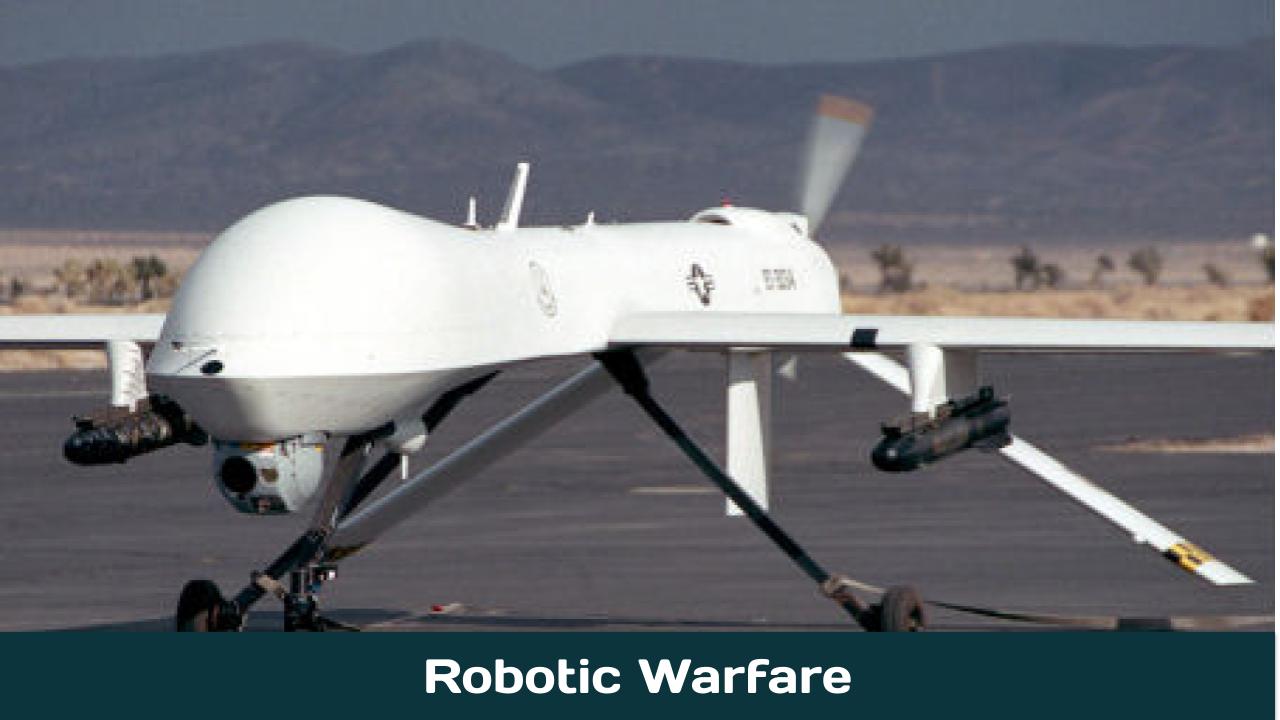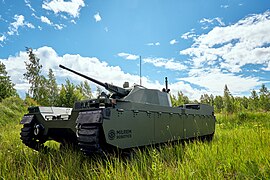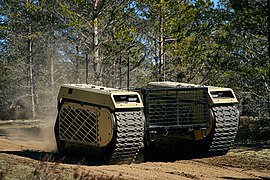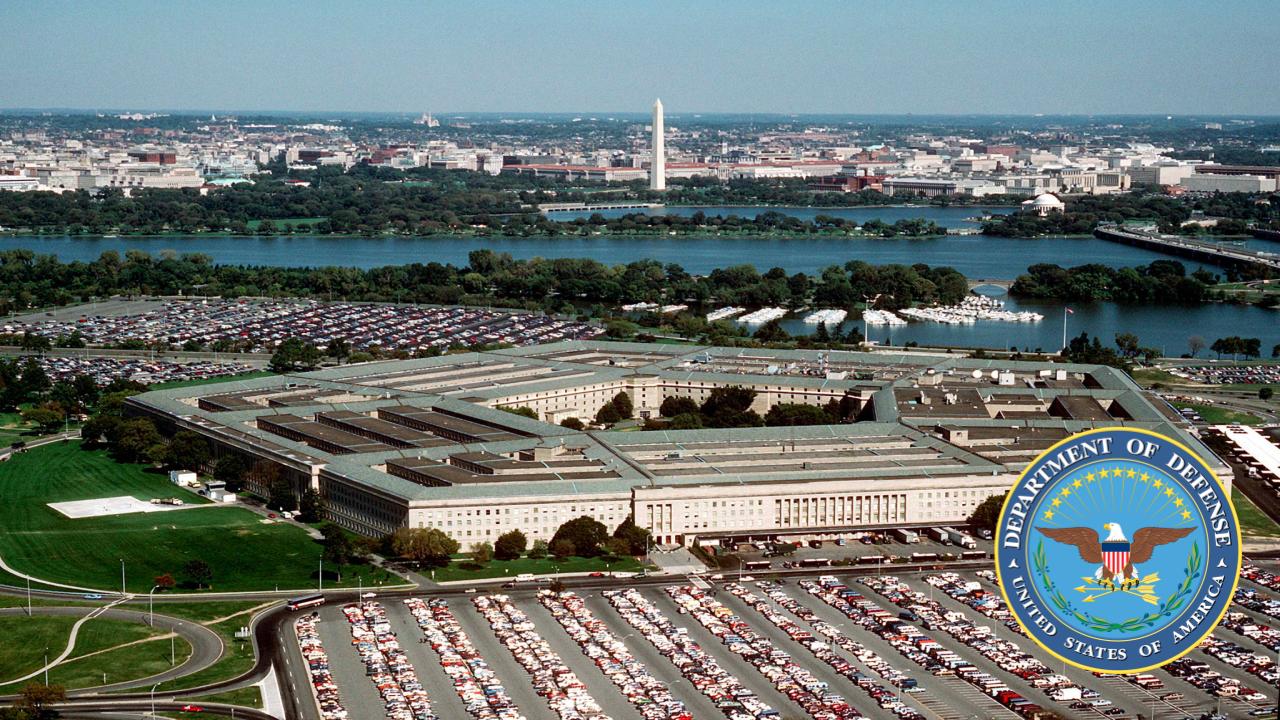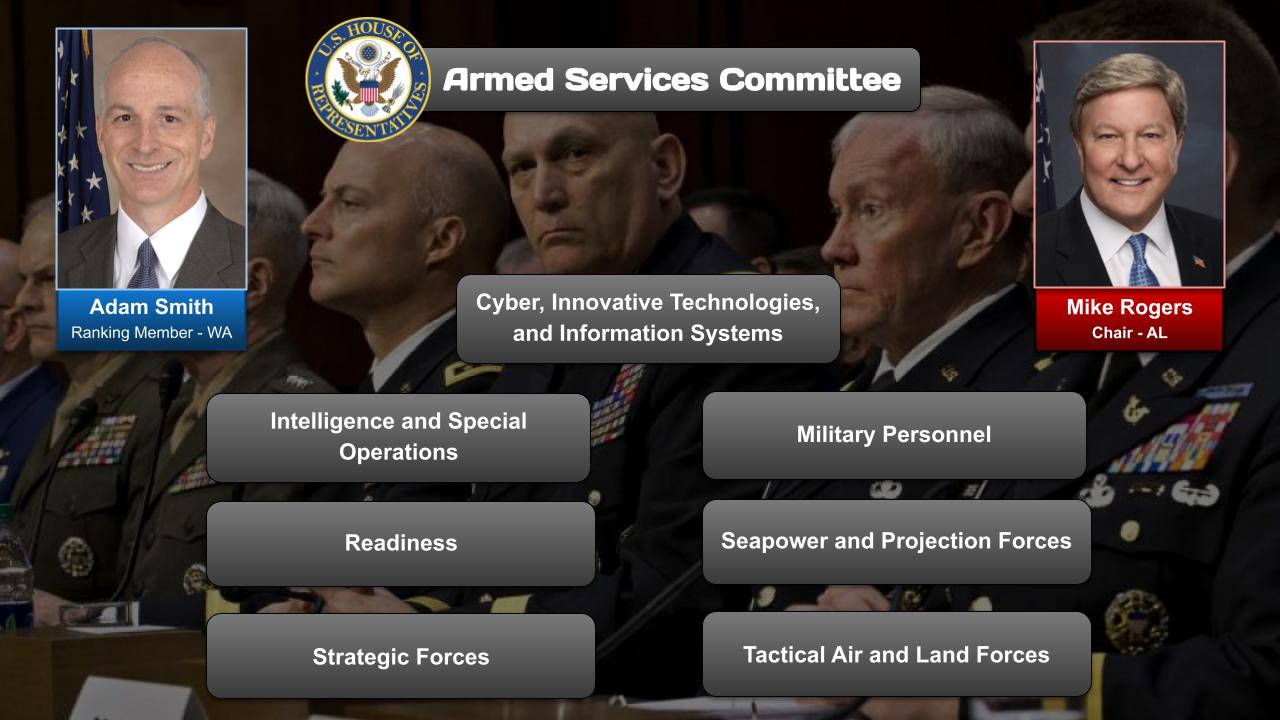Summary
This post on Robotic Warfare is 1 of 3 issues that US onAir curators are focusing on in the National Security category.
Military robots are autonomous robots or remote-controlled mobile robots designed for military applications, from transport to search & rescue and attack.
OnAir Post: Robotic Warfare
News
PBS NewsHour – December 13, 2023 (08:00)
With Congress deadlocked on whether to approve tens of billions of dollars in additional aid for Ukraine, that nation’s domestic arms industry is becoming increasingly important. Perhaps the most vital weapons system it’s producing is an army of drones. Nick Schifrin and videographer Eric O’Connor visited the frontline in southern Ukraine to understand how drones have transformed the war.
About
Check the National Security post for the party positions, committees, government agencies related to Robotic Warfare issues.
Challenges
Ethical Implications:
- Balancing the use of lethal autonomous weapons with humanitarian concerns
- Defining ethical boundaries for AI decision-making in warfare
- Assessing the potential risks and unintended consequences of autonomous systems
2. Technological Limitations:
- Developing AI systems that can reliably interpret complex battlefield situations
- Ensuring the robustness and resilience of autonomous systems against cyber and electronic warfare
- Addressing the challenges of autonomous navigation in urban and cluttered environments
3. Command and Control:
- Establishing clear lines of authority and accountability for decision-making in robotic warfare
- Determining the appropriate level of human oversight and control over autonomous systems
- Managing potential conflicts between human and AI decision-making
4. Interoperability and Standards:
- Facilitating the seamless integration of robotic systems from different manufacturers
- Developing common standards for communication, data sharing, and coordination
- Ensuring compatibility with existing military systems
5. Cybersecurity:
- Protecting robotic systems from hacking and sabotage
- Establishing secure communication links and data transfer protocols
- Detecting and responding to cyber threats targeting autonomous systems
6. Legal and Policy Considerations:
- Establishing clear legal frameworks for the use of robotic warfare
- Defining the boundaries of legitimate targets and permissible uses of autonomous weapons
- Addressing accountability and responsibility for actions taken by autonomous systems
7. Public Acceptance:
- Overcoming public concerns about the use of robotic weapons
- Ensuring transparency and accountability for the development and deployment of autonomous systems
- Engaging with civil society organizations and the media to address ethical and societal implications
8. Cost and Resource Allocation:
- Balancing the investment in robotic warfare with other defense priorities
- Assessing the long-term costs and benefits of autonomous systems
- Managing the budget and resources necessary to support robotic warfare capabilities
Source: Google Search + Gemini + onAir curation
Solutions
Legal and Ethical Framework:
- Establish clear legal and ethical guidelines for the use of robotic warfare systems.
- Define the roles and responsibilities of operators, commanders, and policymakers.
- Address concerns about autonomous decision-making and accountability.
2. Technological Advancement:
- Invest in research and development of more capable robotic warfare systems.
- Focus on improving autonomy, intelligence, and situational awareness.
- Explore new platforms and technologies, such as swarm robotics and unmanned aerial vehicles.
3. Interoperability and Joint Operations:
- Develop standards and protocols for interoperability between different robotic warfare systems.
- Ensure seamless integration of robotic systems into existing military operations.
- Facilitate joint operations with human soldiers and robotic systems.
4. Human-Machine Interaction:
- Design robotic warfare systems with effective human-machine interfaces.
- Ensure operators have control over the actions of robotic systems.
- Train operators to effectively use and interpret data from robotic sensors.
5. Cybersecurity:
- Protect robotic warfare systems from cyberattacks and vulnerabilities.
- Implement robust cybersecurity measures to prevent unauthorized access or manipulation.
- Establish protocols for responding to cyber incidents.
6. Battlefield Management:
- Develop tools and techniques for managing and coordinating robotic warfare systems on the battlefield.
- Establish procedures for situational awareness, decision-making, and command and control.
- Ensure robotic operations are integrated with human-led operations.
7. Training and Education:
- Provide comprehensive training for operators, commanders, and policymakers on the use of robotic warfare systems.
- Develop specialized training programs for operating and maintaining robotic systems.
- Educate the public on the implications and potential benefits of robotic warfare.
8. International Cooperation:
- Engage in international dialogue and cooperation on the development and use of robotic warfare systems.
- Promote responsible use and prevent the proliferation of autonomous weapon systems.
- Establish international norms and standards for robotic warfare.
9. Risk Assessment and Mitigation:
- Conduct thorough risk assessments before fielding robotic warfare systems.
- Identify potential vulnerabilities and develop mitigation strategies.
- Implement measures to minimize civilian casualties and damage to infrastructure.
10. Research and Development for the Future:
- Invest in long-term research and development to explore new technologies and concepts.
- Consider the implications of emerging technologies, such as artificial intelligence and quantum computing.
- Anticipate future challenges and develop solutions accordingly.
Source: Google Search + Gemini + onAir curation
Websites
Government Agencies:
- Defense Advanced Research Projects Agency (DARPA): https://www.darpa.mil/
- Department of Defense (DoD): https://www.defense.gov/
- Office of the Under Secretary of Defense for Research and Engineering (OUSD(R&E)): https://www.ousdre.mil/
- Robotics and Autonomous Systems (RAS) Division, OUSD(R&E): https://www.ousdre.mil/ps/ras/
Industry Groups:
- Aerospace Industries Association (AIA): https://www.aia-aerospace.org/
- Association for Unmanned Vehicle Systems International (AUVSI): https://www.auvsi.org/
- National Defense Industrial Association (NDIA): https://www.ndia.org/
Research Institutions:
- Carnegie Mellon University, Robotics Institute: https://www.ri.cmu.edu/
- Georgia Institute of Technology, Institute for Robotics and Intelligent Machines: https://www.ri.gatech.edu/
- Massachusetts Institute of Technology, Computer Science and Artificial Intelligence Laboratory (CSAIL): https://www.csail.mit.edu/
- Stanford University, Artificial Intelligence Lab: https://ai.stanford.edu/
Think Tanks and Policy Groups:
- Center for a New American Security (CNAS): https://www.cnas.org/
- RAND Corporation: https://www.rand.org/
- Stimson Center: https://www.stimson.org/
Other Resources:
- National Science Foundation (NSF), Program on Robotics and Cyber-Physical Systems: https://www.nsf.gov/funding/pgm_summ.jsp?pims_id=501127
- Association for the Advancement of Artificial Intelligence (AAAI): https://www.aaai.org/
- Institute of Electrical and Electronics Engineers (IEEE), Robotics and Automation Society: https://www.ieee-ras.org/
Source: Google Search + Gemini + onAir curation
Legislation
See Congress.Gov links below for latest updates and for learning what bills your representatives are sponsoring.
Laws
Source: Google Search + Gemini + onAir curation
National Defense Authorization Act (NDAA)
- 2021 NDAA: Established the Joint Artificial Intelligence Center (JAIC) and directed the Department of Defense (DoD) to develop a comprehensive strategy for responsible AI use in military operations, including robotic warfare.
- 2023 NDAA: Requires the DoD to report on the ethical and legal implications of robotic warfare, including the use of lethal autonomous weapons systems (LAWS).
Department of Defense Directives and Instructions
- DoD Directive 3000.09 (2012): Establishes DoD policies and procedures for the development, testing, and employment of autonomous systems, including robotic warfare systems.
- DoD Instruction 5000.02 (2017): Provides guidance on the ethical and responsible use of AI and autonomous systems in military operations.
Other Key Laws
- Artificial Intelligence Research and Development Act of 2019: Supports research and development of AI technologies, including for use in military applications.
- National Artificial Intelligence Act of 2020: Creates a National AI Advisory Commission to advise the federal government on AI policy and investment priorities.
- Executive Order on Maintaining American Leadership in Artificial Intelligence (2019): Establishes a national strategy for AI development and investment, including for military applications.
International Agreements
- Convention on Certain Conventional Weapons (CCW): Prohibits the use of LAWS without human oversight.
- Joint Statement on Lethal Autonomous Weapons (2018): Affirms the need for responsible AI development and use in military operations.
Additional Considerations
- Legislative proposals such as the “Autonomous Weapons Accountability Act” aim to further restrict the use of LAWS.
- Ethical and legal concerns about the potential for bias, discrimination, and unintended consequences in robotic warfare continue to be debated.
- Congressional oversight will play a crucial role in ensuring responsible AI development and use in military applications.
New Bills in 2023-2024
Source: Google Search + Gemini + onAir curation
National Defense Authorization Act (NDAA) for Fiscal Year 2024 (S. 4543)
- Includes provisions for:
- Research and development of autonomous and semi-autonomous robotic systems for military applications
- Establishment of a Joint Artificial Intelligence Center (JAIC) to coordinate AI development across the Department of Defense (DoD)
- Increased funding for cybersecurity and infrastructure protection to counter threats from robotic warfare
Artificial Intelligence for National Security Act (H.R. 1232)
- Creates a National Artificial Intelligence Advisory Board to provide guidance on the responsible development and use of AI in national security
- Directs the DoD to develop a strategy for using AI in warfare, including ethical considerations and risk mitigation
Robotics Development and Integration Act (H.R. 766)
- Establishes a National Robotics Institute to foster collaboration between academia, industry, and government on robotics development
- Provides funding for robotics research and development, with a focus on applications in defense, healthcare, and other critical sectors
National Robotics Workforce Development Act (S. 2312)
- Creates a National Robotics Workforce Development Program to train and certify the workforce for the expanding robotics industry
- Provides funding for educational programs, apprenticeships, and other initiatives to build a robust and skilled robotics workforce
Autonomous Vehicles Safety Act (H.R. 3388)
- Establishes safety standards for the development, testing, and deployment of autonomous vehicles on public roads
- Addresses issues related to cybersecurity, liability, and ethical considerations in the use of autonomous vehicles for military purposes
Ethical Considerations for the Use of Artificial Intelligence in Warfare Act (S. 2787)
- Directs the DoD to develop and implement ethical guidelines for the use of AI in warfare
- Establishes a commission to review the implications of AI-powered weapons systems and make recommendations for their responsible development and use
Critical Infrastructure Protection and Modernization Act (H.R. 2885)
- Provides funding for the modernization and protection of critical infrastructure, including from threats posed by robotic warfare
- Directs the Department of Homeland Security (DHS) to develop a strategy for countering threats from autonomous systems
Committees, Agencies, & Programs
Committees
Source: Google Search + Gemini + onAir curation
House of Representatives Committees:
- House Armed Services Committee: Oversees all aspects of the military, including the development and use of robotic warfare systems.
- House Committee on Foreign Affairs: Addresses the international implications of robotic warfare, such as arms control and nonproliferation.
- House Committee on Science, Space, and Technology: Explores the technological advancements and ethical considerations related to robotic warfare.
Senate Committees:
- Senate Armed Services Committee: Similar responsibilities to the House Armed Services Committee.
- Senate Committee on Foreign Relations: Focuses on the diplomatic and strategic aspects of robotic warfare.
- Senate Committee on Commerce, Science, and Transportation: Reviews the commercial and technological implications of robotic warfare systems.
Joint Congressional Committees:
- Armed Services Committee (JASC): A joint committee of the House and Senate that addresses issues related to the military, including robotic warfare.
Other Relevant Committees:
- House Judiciary Committee: Considers the legal and ethical implications of robotic warfare.
- House Oversight and Reform Committee: Investigates the use and regulation of robotic warfare systems.
- Senate Judiciary Committee: Reviews the constitutional and legal aspects of robotic warfare.
- Senate Governmental Affairs Committee: Examines the government’s role in the development and use of robotic warfare technology.
Additional Considerations:
- Congressional committees often work together on issues related to robotic warfare, such as the Subcommittee on Emerging Threats and Capabilities within the House Armed Services Committee.
- Members of Congress from both parties have expressed concerns about the ethical and legal challenges posed by robotic warfare, leading to the formation of bipartisan caucuses on the subject.
Government Agencies
Source: Google Search + Gemini + onAir curation
- Department of Defense (DoD)
- Joint Artificial Intelligence Center (JAIC): Coordinates AI development and integration across the DoD.
- Defense Advanced Research Projects Agency (DARPA): Funds cutting-edge research and development in robotics and AI.
- Office of the Under Secretary of Defense for Research and Engineering (OUSD(R&E)): Oversees DoD’s science and technology programs, including robotics.
- Department of Energy (DOE)
- National Nuclear Security Administration (NNSA): Responsible for maintaining the US nuclear arsenal, which includes robotics systems.
- Department of Homeland Security (DHS)
- Cybersecurity and Infrastructure Security Agency (CISA): Provides guidance and resources on cybersecurity threats related to robotic warfare.
- Science and Technology Directorate (S&T): Conducts research and development in robotics and AI for homeland security applications.
- National Aeronautics and Space Administration (NASA)
- Jet Propulsion Laboratory (JPL): Develops and operates robotic systems for space exploration, which can provide insights for robotic warfare.
- National Science Foundation (NSF)
- Division of Computer and Network Systems (CNS): Funds research in AI, robotics, and cybersecurity.
- National Institute of Standards and Technology (NIST)
- Public Safety Communications Research (PSCR) Division: Conducts research on communication systems for first responders, including robotics systems.
- Congress
- House Committee on Armed Services: Oversees military programs and policies related to robotic warfare.
- Senate Armed Services Committee: Similar to House Committee on Armed Services but with a focus on the Senate.
- Independent Agencies
- Defense Innovation Unit (DIU): Partners with the private sector to accelerate the development and adoption of emerging technologies, including robotics.
Programs & Initiatives
Source: Google Search + Gemini + onAir curation
Joint Artificial Intelligence Center (JAIC)
- Established in 2018, the JAIC is responsible for coordinating AI development across the Department of Defense (DoD).
- Focuses on developing and fielding AI capabilities for Robotic Warfare, including autonomous decision-making, swarm intelligence, and human-robot collaboration.
2. Defense Advanced Research Projects Agency (DARPA)
- Under the Autonomy in Cyber Environments (ACE) program, DARPA is researching advancements in AI for cyberwarfare operations.
- The Explainable Artificial Intelligence (XAI) program aims to develop AI systems that can explain their decisions and actions.
3. Air Force Research Laboratory (AFRL)
- The AFRL’s Autonomy Research Center is exploring autonomous navigation, targeting, and decision-making for air-based robotic warfare systems.
- The Next Generation Air Dominance (NGAD) program is developing advanced AI capabilities for future unmanned combat aircraft.
4. Army Combat Capabilities Development Command (DEVCOM)
- Through the Future Vertical Lift (FVL) program, DEVCOM is developing a new generation of unmanned aerial vehicles with autonomous flight and combat capabilities.
- The Maneuver Combat Vehicle (MCV) program focuses on developing autonomous ground vehicles for close-quarters combat.
5. Navy Naval Research Laboratory (NRL)
- The NRL’s Autonomous Ship Technologies (AST) program is researching technologies for autonomous navigation, obstacle avoidance, and ship control.
- The Distributed Autonomous Sensing (DAS) program aims to develop swarm intelligence capabilities for distributed sensors and robotic systems.
6. National Robotics Initiative (NRI)
- Funded by the National Science Foundation (NSF), the NRI supports research on fundamental robotics technologies that have applications in Robotic Warfare, such as autonomous mapping, motion planning, and human-robot interaction.
7. Robotic Warfare Ethics
- The DoD has established a Task Force on Legal and Ethical Implications of Artificial Intelligence in Armed Conflict to address ethical and legal considerations related to Robotic Warfare.
- The Algorithmic Warfare Cross-Functional Team (AWCFT) is developing policy guidance on the ethical use of AI in military operations.
Additional Initiatives:
- Interagency Task Force on Autonomy for Cyber Operations (IFACO)
- National AI Initiative
- Advanced Robotics for Manufacturing Institute (ARM)
- Robotics Industry Association (RIA)
More Information
Nonpartisan Organizations
Source: Google Search + Gemini + onAir curation
- Carnegie Endowment for International Peace: The Carnegie Endowment is a global think tank that conducts research on a wide range of international issues, including robotic warfare. The Endowment’s Technology and International Affairs Program focuses on the implications of new technologies for global security and governance.
- Center for a New American Security: The Center for a New American Security is a bipartisan think tank that focuses on US national security policy. The Center’s Technology and National Security Program analyzes the impact of new technologies on US security interests, including robotic warfare.
- Stimson Center: The Stimson Center is a nonpartisan think tank that focuses on international security and sustainability. The Center’s Managing the Atom Project works to reduce the risks of nuclear weapons proliferation and use. The Project’s work on robotic warfare includes research on the ethical and legal challenges of using autonomous weapons.
- Union of Concerned Scientists: The Union of Concerned Scientists is a nonprofit science advocacy organization that works to promote the responsible use of science and technology. The Union’s Global Security Program focuses on reducing the risks of nuclear weapons and other weapons of mass destruction. The Program’s work on robotic warfare includes research on the technical and ethical challenges of using autonomous weapons.
- Human Rights Watch: Human Rights Watch is an international human rights organization that works to protect the rights of all people around the world. Human Rights Watch’s Arms Division monitors and reports on the development, production, and use of weapons worldwide. The Division’s work on robotic warfare includes research on the human rights implications of using autonomous weapons.
Partisan Organizations
Source: Google Search + Gemini + onAir curation
Democratic Organizations:
- Arms Control Association: Advocates for responsible arms control policies, including limiting the use of autonomous weapons.
- Brennan Center for Justice: Focuses on reforming the criminal justice system, including addressing potential abuses of robotic warfare.
- Center for American Progress: A think tank that promotes progressive policies, including responsible use of technology in warfare.
- Stimson Center: A nonpartisan organization that conducts research on security and peace issues, including robotics and artificial intelligence in warfare.
Republican Organizations:
- American Enterprise Institute: A think tank that promotes conservative policies, including supporting technological advancements in warfare.
- Foundation for Defense of Democracies: Advocates for a strong national defense, including research and development of advanced weapons systems.
- Heritage Foundation: A conservative think tank that supports limited government and a strong military, including the use of robotics in warfare.
- Hoover Institution: A research center that studies public policy issues, including the impact of technology on society and warfare.
“Military robot” (Wiki)
Contents

Military robots are autonomous robots or remote-controlled mobile robots designed for military applications, from transport to search & rescue and attack.
Some such systems are currently in use, and many are under development.
| Part of a series on |
| War |
|---|
 |
History


Broadly defined, military robots date back to World War II and the Cold War in the form of the German Goliath tracked mines and the Soviet teletanks. The introduction of the MQ-1 Predator drone was when “CIA officers began to see the first practical returns on their decade-old fantasy of using aerial robots to collect intelligence”.[1]
The use of robots in warfare, although traditionally a topic for science fiction, is being researched as a possible future means of fighting wars. Already several military robots have been developed by various armies. Some believe the future of modern warfare will be fought by automated weapons systems.[2] The U.S. military is investing heavily in the RQ-1 Predator, which can be armed with air-to-ground missiles and remotely operated from a command center in reconnaissance roles. DARPA has hosted competitions in 2004 & 2005 to involve private companies and universities to develop unmanned ground vehicles to navigate through rough terrain in the Mojave Desert for a final prize of 2 million.[3]
Artillery has seen promising research with an experimental weapons system named “Dragon Fire II” which automates loading and ballistics calculations required for accurate predicted fire, providing a 12-second response time to fire support requests. However, military weapons are prevented from being fully autonomous; they require human input at certain intervention points to ensure that targets are not within restricted fire areas as defined by Geneva Conventions for the laws of war.
There have been some developments towards developing autonomous fighter jets and bombers.[4] The use of autonomous fighters and bombers to destroy enemy targets is especially promising because of the lack of training required for robotic pilots, autonomous planes are capable of performing maneuvers which could not otherwise be done with human pilots (due to high amount of G-force), plane designs do not require a life support system, and a loss of a plane does not mean a loss of a pilot. However, the largest drawback to robotics is their inability to accommodate for non-standard conditions. Advances in artificial intelligence in the near future may help to rectify this.
In 2020 a Kargu 2 drone hunted down and attacked a human target in Libya, according to a report from the UN Security Council’s Panel of Experts on Libya, published in March 2021. This may have been the first time an autonomous killer robot armed with lethal weaponry attacked human beings.[5][6]
Examples
In current use
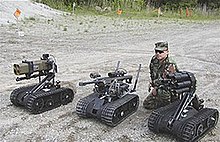

- D9T Panda, Israel
- Elbit Hermes 450, Israel
- Goalkeeper CIWS
- Guardium[8]
- IAIO Fotros, Iran
- PackBot
- MQ-9 Reaper
- MQ-1 Predator
- TALON
- Samsung SGR-A1[9]
- Shahed 129, Iran
- Baykar Bayraktar TB2, Turkey
- Albatross, Taiwan
- Shomer Gvouloth (“Border Keeper”), Israel
- THeMIS, Estonia
- PLA robot soldiers, deployed on the China-India border [10]
In development

- MIDARS, a four-wheeled robot outfitted with several cameras, radar, and possibly a firearm, that automatically performs random or preprogrammed patrols around a military base or other government installation. It alerts a human overseer when it detects movement in unauthorized areas, or other programmed conditions. The operator can then instruct the robot to ignore the event, or take over remote control to deal with an intruder, or to get better camera views of an emergency. The robot would also regularly scan radio frequency identification tags (RFID) placed on stored inventory as it passed and report any missing items.
- Tactical Autonomous Combatant (TAC) units, described in Project Alpha study Unmanned Effects: Taking the Human out of the Loop.[11]
- Autonomous Rotorcraft Sniper System is an experimental robotic weapons system being developed by the U.S. Army since 2005.[12][13] It consists of a remotely operated sniper rifle attached to an unmanned autonomous helicopter.[14] It is intended for use in urban combat or for several other missions requiring snipers.[15] Flight tests are scheduled to begin in summer 2009.[12]
- The “Mobile Autonomous Robot Software” research program was started in December 2003 by the Pentagon who purchased 15 Segways in an attempt to develop more advanced military robots.[16] The program was part of a $26 million Pentagon program to develop software for autonomous systems.[16]
- ACER
- Atlas (robot)
- Battlefield Extraction-Assist Robot
- Dassault nEUROn (French UCAV)
- Dragon Runner
- MATILDA
- MULE (US UGV)
- R-Gator
- Ripsaw MS1 [1]
- SUGV
- Syrano
- iRobot Warrior
- PETMAN
- Excalibur unmanned aerial vehicle
- Teng Yun medium size reconnaissance UAV program, Taiwan
Effects and impact
Advantages
Autonomous robotics would save and preserve soldiers’ lives by removing serving soldiers, who might otherwise be killed, from the battlefield. Lt. Gen. Richard Lynch of the United States Army Installation Management Command and assistant Army chief of staff for installation stated at a 2011 conference:
As I think about what’s happening on the battlefield today … I contend there are things we could do to improve the survivability of our service members. And you all know that’s true.[17]
Major Kenneth Rose of the US Army’s Training and Doctrine Command outlined some of the advantages of robotic technology in warfare:[18]
Machines don’t get tired. They don’t close their eyes. They don’t hide under trees when it rains and they don’t talk to their friends … A human’s attention to detail on guard duty drops dramatically in the first 30 minutes … Machines know no fear.
Increasing attention is also paid to how to make the robots more autonomous, with a view of eventually allowing them to operate on their own for extended periods of time, possibly behind enemy lines. For such functions, systems like the Energetically Autonomous Tactical Robot are being tried, which is intended to gain its own energy by foraging for plant matter. The majority of military robots are tele-operated and not equipped with weapons; they are used for reconnaissance, surveillance, sniper detection, neutralizing explosive devices, etc. Current robots that are equipped with weapons are tele-operated so they are not capable of taking lives autonomously.[19] Advantages regarding the lack of emotion and passion in robotic combat is also taken into consideration as a beneficial factor in significantly reducing instances of unethical behavior in wartime. Autonomous machines are created not to be “truly ‘ethical’ robots”, yet ones that comply with the laws of war (LOW) and rules of engagement (ROE).[20] Hence the fatigue, stress, emotion, adrenaline, etc. that affect a human soldier’s rash decisions are removed; there will be no effect on the battlefield caused by the decisions made by the individual.
Risks
Human rights groups and NGOs such as Human Rights Watch and the Campaign to Stop Killer Robots have started urging governments and the United Nations to issue policy to outlaw the development of so-called “lethal autonomous weapons systems” (LAWS).[21] The United Kingdom opposed such campaigns, with the Foreign Office declaring that “international humanitarian law already provides sufficient regulation for this area”.[22]
In July 2015, over 1,000 experts in artificial intelligence signed a letter calling for a ban on autonomous weapons. The letter was presented in Buenos Aires at the 24th International Joint Conference on Artificial Intelligence (IJCAI-15) and was co-signed by Stephen Hawking, Elon Musk, Steve Wozniak, Noam Chomsky, Skype co-founder Jaan Tallinn and Google DeepMind co-founder Demis Hassabis, among others.[23][24]
Psychology
American soldiers have been known to name the robots that serve alongside them. These names are often in honor of human friends, family, celebrities, pets, or are eponymic.[25] The ‘gender’ assigned to the robot may be related to the marital status of its operator.[25]
Some affixed fictitious medals to battle-hardened robots, and even held funerals for destroyed robots.[25] An interview of 23 explosive ordnance detection members shows that while they feel it is better to lose a robot than a human, they also felt anger and a sense of loss if they were destroyed.[25] A survey of 746 people in the military showed that 80% either ‘liked’ or ‘loved’ their military robots, with more affection being shown towards ground rather than aerial robots.[25] Surviving dangerous combat situations together increased the level of bonding between soldier and robot, and current and future advances in artificial intelligence may further intensify the bond with the military robots.[25]
In fictional media
Pictures
- UGV TALON Gen. IV (USA)
- UGV “PIRANYA” (Ukraine)
- Type-X (Estonia)
- THeMIS (Estonia)
- Uran-9 (Russia)
- Berserk (Belarus)
- Sea Hunter (USA)
- Miloš L (UGV), a military robot for evacuating the wounded from the battlefield
See also
- DARPA Grand Challenge
- Lethal autonomous weapon
- Human-in-the-loop
- Missile guidance
- Multi Autonomous Ground-robotic International Challenge
- Network-centric warfare
- Powered exoskeleton
- Roboethics
- Robot combat
- Robot Wars (disambiguation)
- Supersoldier
- Telerobotics
- Three Laws of Robotics
- Unmanned combat air vehicle
References
- ^ Steve Coll, Ghost Wars (Penguin, 2005 edn), pp.529 and 658 note 6.
- ^ Robots and Robotics at the Space and Naval Warfare Systems Center Pacific Archived 1999-02-20 at the Wayback Machine
- ^ “Welcome to Grandchallenge”. www.grandchallenge.org. Archived from the original on 2007-10-11.
- ^ Talbot, David. “The Ascent of the Robotic Attack Jet”. MIT Technology Review.
- ^ Hambling, David. “Drones may have attacked humans fully autonomously for the first time”. New Scientist. Retrieved 2021-05-30.
- ^ “Killer drone ‘hunted down a human target’ without being told to”. New York Post. 2021-05-29. Retrieved 2021-05-30.
- ^ ““Платформа-М”: Роботизированный комплекс широких возможностей”. arms-expo.ru. Archived from the original on 2016-03-04.
- ^ Guardium Military robot Archived 2005-10-26 at the Wayback Machine
- ^ Korean gun bots Archived 2011-01-15 at the Wayback Machine theregister.co.uk
- ^ “Gravitas: China deploys ‘Robot Soldiers’ along the border with India – Gravitas News”.
- ^ Schafer, Ron (July 29, 2003). “Robotics to play major role in future warfighting”. United States Joint Forces Command. Archived from the original on August 13, 2003. Retrieved 2013-04-30.
{{cite web}}: CS1 maint: unfit URL (link) - ^ a b Page, Lewis (21 April 2009). “Flying-rifle robocopter: Hovering sniper backup for US troops”. The Register. Archived from the original on 24 April 2009. Retrieved 2009-04-21.
- ^ “U.S. Army Tests Flying Robot Sniper”. Fox News. 2009-04-22. Archived from the original on 2009-04-26. Retrieved 2009-04-23.
- ^ Hambling, David (May 2009). “UAV Helicopter Brings Finesse to Airstrikes”. Popular Mechanics. Archived from the original on 2009-04-21. Retrieved 2009-04-21.
- ^ Hambling, David (April 21, 2009). “Army Tests Flying Robo-Sniper”. Wired, “Danger Room” blog. Archived from the original on April 23, 2009. Retrieved 2009-04-21.
- ^ a b “Military wants to transform Segway scooters into robots”. seattlepi.com. 2003-12-02. Retrieved 2009-04-24.
- ^ Cheryl Pellerin (American Forces Press Service) – DoD News:Article published Aug. 17, 2011 Archived 2015-07-14 at the Wayback Machine published by the U.S. Department of Defense, WASHINGTON (DoD) [Retrieved 2015-07-28]
- ^ “Robot soldiers”. BBC News. 2002-04-12. Archived from the original on 2011-01-25. Retrieved 2010-05-12.
- ^ Hellström, Thomas (June 2013). “On the moral responsibility of military robots”. Ethics and Information Technology. 15 (2): 99–107. CiteSeerX 10.1.1.305.5964. doi:10.1007/s10676-012-9301-2. S2CID 15205810.
- ^ Lin, Bekey, Abney, Patrick, George, Keith (2009). “Robots in War: Issues of Risk and Ethics”. Archived from the original on 2015-11-23.
{{cite web}}: CS1 maint: multiple names: authors list (link) - ^ Bowcott, Owen Bowcott (9 April 2015). “UN urged to ban ‘killer robots’ before they can be developed”. the Guardian. Archived from the original on 2015-07-28. Retrieved 2015-07-28.
- ^ Bowcott, Owen (13 April 2015). “UK opposes international ban on developing ‘killer robots’“. the Guardian. Archived from the original on 2015-07-29. Retrieved 2015-07-28.
- ^ Gibbs, Samuel (27 July 2015). “Musk, Wozniak and Hawking urge ban on warfare AI and autonomous weapons”. the Guardian. Archived from the original on 2015-07-27. Retrieved 2015-07-28.
- ^ “Musk, Hawking Warn of Artificial Intelligence Weapons”. WSJ Blogs – Digits. 2015-07-27. Archived from the original on 2015-07-28. Retrieved 2015-07-28.
- ^ a b c d e f Nidhi Subbaraman. “Soldiers <3 robots: Military bots get awards, nicknames … funerals”. NBC News. Archived from the original on 2013-10-06.
External links
- “Biomass military robot in development”
- EATR: Energetically Autonomous Tactical Robot – Phase II Project
Ethical and legal concerns
- Gerhard Dabringer (Hg.), Ethica Themen: Ethical and Legal Aspects of Unmanned Systems. Interviews, Wien 2010
- Public Say It’s Illegal to Target Americans Abroad as Some Question CIA Drone Attacks, according to Fairleigh Dickinson University PublicMind poll – February 7, 2013
- The future of warfare: Why we should all be very afraid (2014-07-21), Rory Tolan, Salon
- Archive on air wars, Geographical Imaginations
- Logical Limitations to Machine Ethics, with Consequences to Lethal Autonomous Weapons. Also discussed in: Does the Halting Problem Mean No Moral Robots?
- Robots in War: Issues of Risk and Ethics – 2009
Organizations
- United States Joint Forces Command website: “Leading the transformation of the U.S. military”
- irobot.com, builder of the PackBot and the R-Gator systems
- Boston Dynamics, builder of BigDog
News articles/press releases
- USJFC: ‘Robotics to play major role in future warfighting’
- “From bomb disposal to waste disposal” Archived 2015-07-09 at the Wayback Machine Robots help deal with hazards, emergencies and disasters (International Electrotechnical Commission, July 2011)
- “War robots still in Iraq”, DailyTech, April 17, 2008
- New Model Army Soldier Rolls Closer to Battle (SWORDS)
- TALON Small Mobile Robot
- TWG Military Robots
- Carnegie Mellon University‘s snooping robot going to Iraq
- PackBot Battlefield robotic Platform Archived 2015-04-05 at the Wayback Machine
- Miniature Unmanned Aerial Systems – UAV
- Guardium Autonomous Security Vehicle
- Unmanned Ground Systems from Israel Archived 2015-05-01 at the Wayback Machine
- High-Tech Military in Due Course Archived 2007-03-11 at the Wayback Machine
- Launching a new kind of warfare
- Gerry J. Gilmore (January 24, 2006). “Army’s Veteran Bomb-Disposal Robot Now ‘Packs Heat’“. American Forces Press Service. Retrieved 2008-02-02.
- As Wars End, Robot Field Faces Reboot April 11, 2012
